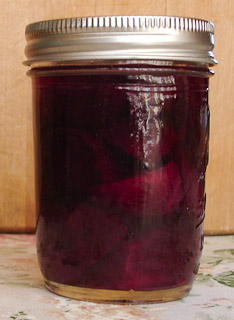
photo by Manon Gaudreau: 8 oz jar of cultured pickled beets; based on recipe from Nourishing Traditions cookbook by Sally Fallon
For a 1 quart jar
- 6-12 beets
- seeds from 2 cardamon pods (optional)
- 1 tablespoon sea salt
- 4 tablespoons homemade whey (if not available, use an additional 1 TBSP of salt)
- 1 cup filtered water (warm enough to easily dissolve salt)
Steam or bake the beets until soft. Peel and cut into pieces. (Do not grate or cut the beets with a food processor as this releases too much juice and the fermentation will be too fast and will favor formation of alcohol rather than lactic acid). Put the beet in a quart-sized, wide-mouth jar and press down. Combine the remaining ingredients and pour over beets, adding more salt-water if necessary to cover the beets. The top of the liquid should be at least 1 inch below the top of the jar. Cover tightly and keep at room temperature for about 3 days before transferring to cold storage where the beets will keep for months.
Make sure the beets are submerged in the liquid, and that no air pockets remain in the jar , as exposure to air promotes development of mold. Sake the jar to remove air bubbles. If need be, for the first 3 days of fermentation at room temperature, keep a weight on top of the beets, such as a wooden disk, or a small glass bottle that fits inside the mouth of the pickling jar, or a closed plastic bag filled with salt-water (in case its leaks), to keep the ferments immersed, and cover with a cloth or plastic to keep bugs away. A little space between the edge of the jar and the weight is acceptable, as long as only the liquid is exposed. Every day, lift the covering and remove any foam that may have developed on the surface of the jar and rinse the weight if necessary, before covering again. After 3 days, remove the weight, put an air-tight lid on the jar, and transfer to the refrigerator or to cold storage.
Lacto-fermented beets are less acid than beets conserved in vinegar. Once the beets have been eaten, make sure you consume the juice as well. Use it as a vinegar for salad dressing, or add it to soups and stews, or dilute it with water and drink it as a tonic. Read more about beets.

Recent Comments